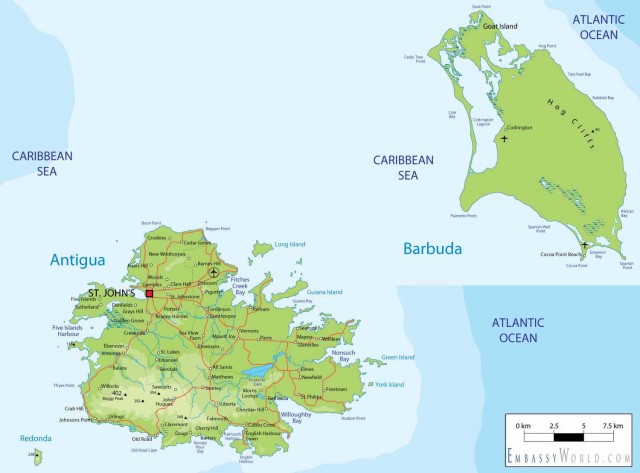Antigua and Barbuda
Area 173 square mi (443 square km)
Capital Saint John's
Population 90,900 2014
Highest Point 1,326 ft (402 m)
Lowest Point 0 m
GDP $1.269 billion 2014
Primary Natural Resources pleasant tropical climate.
ANTIGUA WAS ONE of the primary British colonies in the CARIBBEAN SEA and remains a leader among the Leeward Islands (from the Virgin Islands to GUADELOUPE). Along with the nearby island of Barbuda, and the much smaller island of Redonda, Antigua became independent in 1981 but retains close links with the UNITED KINGDOM (UK) and its commonwealth.

The islands are located in the northern part of the Lesser Antilles chain, approximately 80 km (50 mi) east of SAINT KITTS AND NEVIS, and the same distance north of the French island Guadeloupe. Unlike these neighbors, none of the three main islands are volcanic and mountainous but are low-lying coral and limestone formations. Antigua was one of the first islands encountered in the voyages of Christopher Columbus, who named it Santa Maria de la Antigua. The Spanish and French attempted to set up colonies but were discouraged by lack of fresh water and attacks by native Carib peoples. English planters established a permanent settlement in the 1630s and within a few decades had completely deforested the island, eradicated any native population, and repopulated it with large numbers of African slaves. The chief city, St. John's, was one of the region's most prosperous ports in the 18th century as a center for the sugar trade but declined after the abolition of slavery in 1834. Nelson's Dockyard, on the south side of the island, remains a testament to this prosperity and has been a national park since the 1980s. Sugar remained the island's major product until the 1960s but has now mostly disappeared.
Barbuda, 30 mi (48 km) to the north, was never developed as a commercial sugar producer, and it retains a separate identity from its larger, more populous partner, occasionally even voicing a desire for autonomy or independence from Antigua. Most of its 1,500 residents live in the only settlement, Codrington, named for Antigua's first major planter, who leased Barbuda to raise provisions and conduct slave-breeding experiments. Barbuda is also known among scuba divers and tourists for its numerous sunken ships and untouched reefs.
The tiny volcanic rock of Redonda, only .5 square mi (.8 square km), is located 35 mi (56 km) to the southwest of Antigua. It is populated only by goats, seabirds, and lizards but is the seat of the fabulous “Kingdom of Redonda,” a literary-review group (mostly based in LONDON, England) established in the early 20th century.
The chief natural resource of Antigua and Barbuda is the climate: The tropical marine climate, perpetually sunny skies (bad for crops, good for tourism), and 365 white sandy beaches (one for each day of the year) make these islands one of the most popular tourist destinations. Together with historical settings and abundant duty-free shops in St. John's, the island's tourist economy has given Antigua one of the highest per capita incomes in the Caribbean.